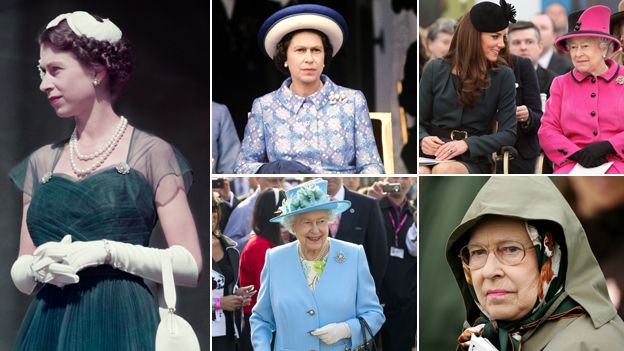Does the Queen do fashion?
- Published

She is one of the most photographed women in the world, but how much of a sartorial influence has the Queen had?
The Queen might be visiting a hospital one day, or welcoming a world leader the next - and her clothes are her uniform.
But just how much has she influenced ordinary women's dress?
"To design a dress for the Queen means you are creating something for the world's most famous woman, who's seen by more people on a daily basis than anyone else. She also has an image in people's minds that you have to fulfil," says Stewart Parvin, who's been designing for the Queen since 2000.
He has to work around the rules - the Queen always wears a two-inch heel, hemlines must be well below the knee, and she always carries a handbag.
"She has to wear strong colours, she's very tiny, and in a block colour with a wonderful hat, she stands out - she's a real focal point," he adds.
Royal historian and biographer Sarah Bradford believes the Queen has developed "a stronger style" over the past year. "She's got more into colour blocking and she looks more pulled together, focusing on bright, light colours.
"She doesn't try and dress like a celebrity, but she does have a certain glamour because of who she is. She can wear a tiara with ease and she doesn't look vulgar, and not many people can pull that off."
The Queen is known for her conservative ensembles, accessorised with sensible shoes and handbags, but five years ago she was listed in Vogue magazine, alongside supermodels Kate Moss, Claudia Schiffer and Naomi Campbell, as one of the 50 most glamorous women in the world.
Grazia magazine's style director, Paula Reed, thinks the Queen is, and always has been, stylish. "There was a moment, six or seven years ago, when suddenly the traditional British thing was cool, and at the Dolce & Gabbana show all the models were wearing below-the-knee tweed skirts, headscarves and big, boxy bags - and the inspiration was so literally, the Queen."
"The clothes are about her, not a style statement - it's very much about the dignity of the role, and even as a very young woman she had that very much at the front of her mind," Reed adds.
Designer Wayne Hemingway believes the Queen's personal taste lies in a certain era - that of Norman Hartnell, who first worked for the then princess in the 1940s. His signature style was full-skirted dresses in sumptuous silks and duchesse satins.
But now he says: "She dresses for her age, which is appropriate, you could never say she's mutton dressed as lamb.
"She doesn't look uncomfortable, she's not a slave to fashion, and that's important. She supports British design, but she's not going to set the fashion world on fire. The most important thing to remember is - don't dress for anybody but yourself, and I think that's what she has in mind."
The Telegraph's fashion expert Hilary Alexander agrees that "in her younger days" the Queen was in step with fashion and certainly had an influence on the fashions of the 50s and 60s, but that "latterly she's very much developed her own style".
"In the 50s there was a state visit to Paris and Norman Hartnell made some incredible gowns for her. She had a tiny waist, an absolute hand-span waist."
Milliner Freddie Fox spent 34 years designing the Queen's hats - including his most photographed creation, a hat with pink bells on that she wore for her Silver Jubilee.
Her hats have become something of a trademark, Fox says, and help her stand out in the crowd, but he agrees with Wayne Hemingway that "comfort is of prime importance in all of her clothing".
"She's a businesswoman who dresses for her lifestyle. It's comfortable, elegant and appropriate."
He believes that many older women try to imitate the Queen's style. "Anybody who is in the public eye, people follow them. I remember that around the time of the Silver Jubilee when the Queen would wear something on a tour, people would immediately snap it up if there was something similar in the shops. Manufacturers would phone me up and say 'you must do some more like that, they're wonderful sellers'."
But, adds Fox, the Queen herself is "not terribly interested in fashion - fashion is what other people do".
Alexander agrees: "She doesn't follow fashion - that would be absolutely ghastly. She always looks appropriate, she always looks smart, she's never overdressed - I think it's the world's best working wardrobe. She's now a woman in her 80s and what she wears is well cut and it's flattering."
With Vogue magazine featuring Queen chic this month, and traditional British heritage brands doing well, many people might be wondering what the Queen will wear for her Jubilee Pageant.
"I think she'll be bright and colourful - it's a quite formulaic approach because she needs bright colours so people can see her and hats have always got to have an upturned brim so her face is not hidden and obviously they must be secured so they don't blow off in the wind. Hems are always weighted so the skirts don't fly up and create a wardrobe malfunction," says Alexander.
So will it be all about functionality at the expense of style? Not at all, says Alexander.
"I think she looks very stylish and she's kind of created her own style. You can't really compare it with what's going on in fashion or with anyone else because what she wears suits her and does what it's supposed to do.
"She always looks like the Queen. We'd be very disappointed if she ever did anything different."
Additional reporting by Keith Moore.